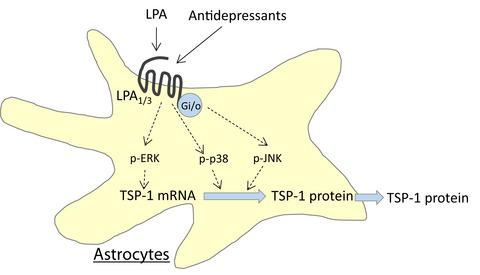当前位置:
X-MOL 学术
›
J. Neurochem.
›
论文详情
Our official English website, www.x-mol.net, welcomes your
feedback! (Note: you will need to create a separate account there.)
Lysophosphatidic acid induces thrombospondin-1 production in primary cultured rat cortical astrocytes
Journal of Neurochemistry ( IF 4.2 ) Pub Date : 2020-10-28 , DOI: 10.1111/jnc.15227 Kazue Hisaoka-Nakashima 1 , Toshiki Yokoe 1 , Shintaro Watanabe 1 , Yoki Nakamura 1 , Naoto Kajitani 2, 3 , Mami Okada-Tsuchioka 3 , Minoru Takebayashi 2, 3 , Yoshihiro Nakata 1 , Norimitsu Morioka 1
Journal of Neurochemistry ( IF 4.2 ) Pub Date : 2020-10-28 , DOI: 10.1111/jnc.15227 Kazue Hisaoka-Nakashima 1 , Toshiki Yokoe 1 , Shintaro Watanabe 1 , Yoki Nakamura 1 , Naoto Kajitani 2, 3 , Mami Okada-Tsuchioka 3 , Minoru Takebayashi 2, 3 , Yoshihiro Nakata 1 , Norimitsu Morioka 1
Affiliation

|
Lysophosphatidic acid (LPA), a brain membrane-derived lipid mediator, plays important roles including neural development, function, and behavior. In the present study, the effects of LPA on astrocyte-derived synaptogenesis factor thrombospondins (TSPs) production were examined by real-time PCR and western blotting, and the mechanism underlying this event was examined by pharmacological approaches in primary cultured rat cortical astrocytes. Treatment of astrocytes with LPA increased TSP-1 mRNA, and TSP-2 mRNA, but not TSP-4 mRNA expression. TSP-1 protein expression and release were also increased by LPA. LPA-induced TSP-1 production were inhibited by AM966 a LPA1 receptor antagonist, and Ki16425, LPA1/3 receptors antagonist, but not by H2L5146303, LPA2 receptor antagonist. Pertussis toxin, Gi/o inhibitor, but not YM-254890, Gq inhibitor, and NF499, Gs inhibitor, inhibited LPA-induced TSP-1 production, indicating that LPA increases TSP-1 production through Gi/o-coupled LPA1 and LPA3 receptors. LPA treatment increased phosphorylation of extracellular signal-regulated kinase (ERK), p38 mitogen-activated protein kinase (MAPK), and c-Jun N-terminal kinase (JNK). LPA-induced TSP-1 mRNA expression was inhibited by U0126, MAPK/ERK kinase (MEK) inhibitor, but not SB202190, p38 MAPK inhibitor, or SP600125, JNK inhibitor. However, LPA-induced TSP-1 protein expression was diminished with inhibition of all three MAPKs, indicating that these signaling molecules are involved in TSP-1 protein production. Treatment with antidepressants, which bind to astrocytic LPA1 receptors, increased TSP-1 mRNA and protein production. The current findings show that LPA/LPA1/3 receptors signaling increases TSP-1 production in astrocytes, which could be important in the pathogenesis of affective disorders and could potentially be a target for the treatment of affective disorders.
中文翻译:

溶血磷脂酸诱导原代培养的大鼠皮质星形胶质细胞产生血小板反应蛋白-1
溶血磷脂酸 (LPA) 是一种脑膜衍生的脂质介质,在神经发育、功能和行为等方面发挥着重要作用。在本研究中,LPA 对星形胶质细胞衍生的突触发生因子血小板反应蛋白 (TSP) 产生的影响通过实时 PCR 和蛋白质印迹进行了检查,并通过药理学方法在原代培养的大鼠皮质星形胶质细胞中检查了这一事件的机制。用LPA 处理星形胶质细胞增加TSP-1 mRNA 和TSP-2 mRNA,但不增加TSP-4 mRNA 表达。LPA 也增加了 TSP-1 蛋白的表达和释放。LPA 诱导的 TSP-1 产生被 AM966(LPA 1受体拮抗剂)和 Ki16425(LPA 1/3受体拮抗剂)抑制,但不受 H2L5146303、LPA 2抑制受体拮抗剂。百日咳毒素,Gi/o 抑制剂,但不是 YM-254890,Gq 抑制剂和 NF499,Gs 抑制剂,抑制 LPA 诱导的 TSP-1 产生,表明 LPA 通过 Gi/o 偶联的 LPA 1和 LPA增加 TSP-1 的产生3受体。LPA 处理增加了细胞外信号调节激酶 (ERK)、p38 丝裂原活化蛋白激酶 (MAPK) 和 c-Jun N 末端激酶 (JNK) 的磷酸化。LPA 诱导的 TSP-1 mRNA 表达被 U0126、MAPK/ERK 激酶 (MEK) 抑制剂抑制,但不受 SB202190、p38 MAPK 抑制剂或 SP600125、JNK 抑制剂的抑制。然而,LPA 诱导的 TSP-1 蛋白表达随着所有三种 MAPK 的抑制而减少,表明这些信号分子参与了 TSP-1 蛋白的产生。与星形胶质细胞 LPA 1受体结合的抗抑郁药治疗增加了 TSP-1 mRNA 和蛋白质的产生。目前的研究结果表明,LPA/LPA 1/3 受体信号增加星形胶质细胞中 TSP-1 的产生,这在情感障碍的发病机制中可能很重要,并可能成为治疗情感障碍的目标。
更新日期:2020-10-28
中文翻译:

溶血磷脂酸诱导原代培养的大鼠皮质星形胶质细胞产生血小板反应蛋白-1
溶血磷脂酸 (LPA) 是一种脑膜衍生的脂质介质,在神经发育、功能和行为等方面发挥着重要作用。在本研究中,LPA 对星形胶质细胞衍生的突触发生因子血小板反应蛋白 (TSP) 产生的影响通过实时 PCR 和蛋白质印迹进行了检查,并通过药理学方法在原代培养的大鼠皮质星形胶质细胞中检查了这一事件的机制。用LPA 处理星形胶质细胞增加TSP-1 mRNA 和TSP-2 mRNA,但不增加TSP-4 mRNA 表达。LPA 也增加了 TSP-1 蛋白的表达和释放。LPA 诱导的 TSP-1 产生被 AM966(LPA 1受体拮抗剂)和 Ki16425(LPA 1/3受体拮抗剂)抑制,但不受 H2L5146303、LPA 2抑制受体拮抗剂。百日咳毒素,Gi/o 抑制剂,但不是 YM-254890,Gq 抑制剂和 NF499,Gs 抑制剂,抑制 LPA 诱导的 TSP-1 产生,表明 LPA 通过 Gi/o 偶联的 LPA 1和 LPA增加 TSP-1 的产生3受体。LPA 处理增加了细胞外信号调节激酶 (ERK)、p38 丝裂原活化蛋白激酶 (MAPK) 和 c-Jun N 末端激酶 (JNK) 的磷酸化。LPA 诱导的 TSP-1 mRNA 表达被 U0126、MAPK/ERK 激酶 (MEK) 抑制剂抑制,但不受 SB202190、p38 MAPK 抑制剂或 SP600125、JNK 抑制剂的抑制。然而,LPA 诱导的 TSP-1 蛋白表达随着所有三种 MAPK 的抑制而减少,表明这些信号分子参与了 TSP-1 蛋白的产生。与星形胶质细胞 LPA 1受体结合的抗抑郁药治疗增加了 TSP-1 mRNA 和蛋白质的产生。目前的研究结果表明,LPA/LPA 1/3 受体信号增加星形胶质细胞中 TSP-1 的产生,这在情感障碍的发病机制中可能很重要,并可能成为治疗情感障碍的目标。











































 京公网安备 11010802027423号
京公网安备 11010802027423号